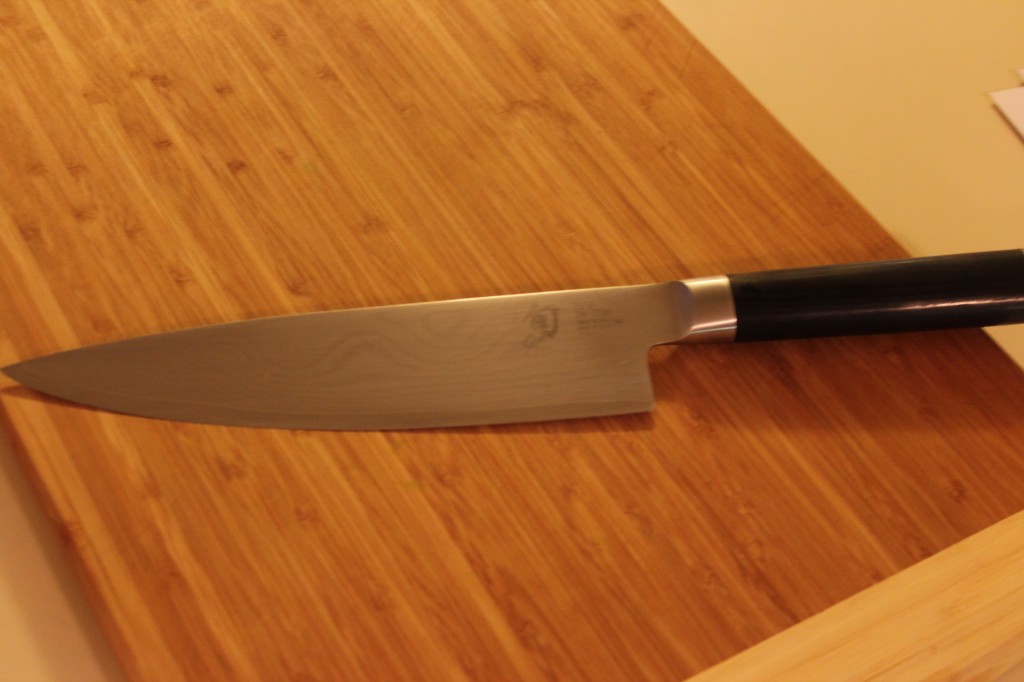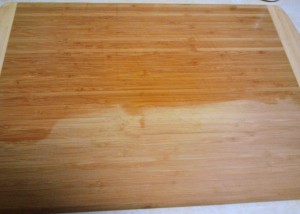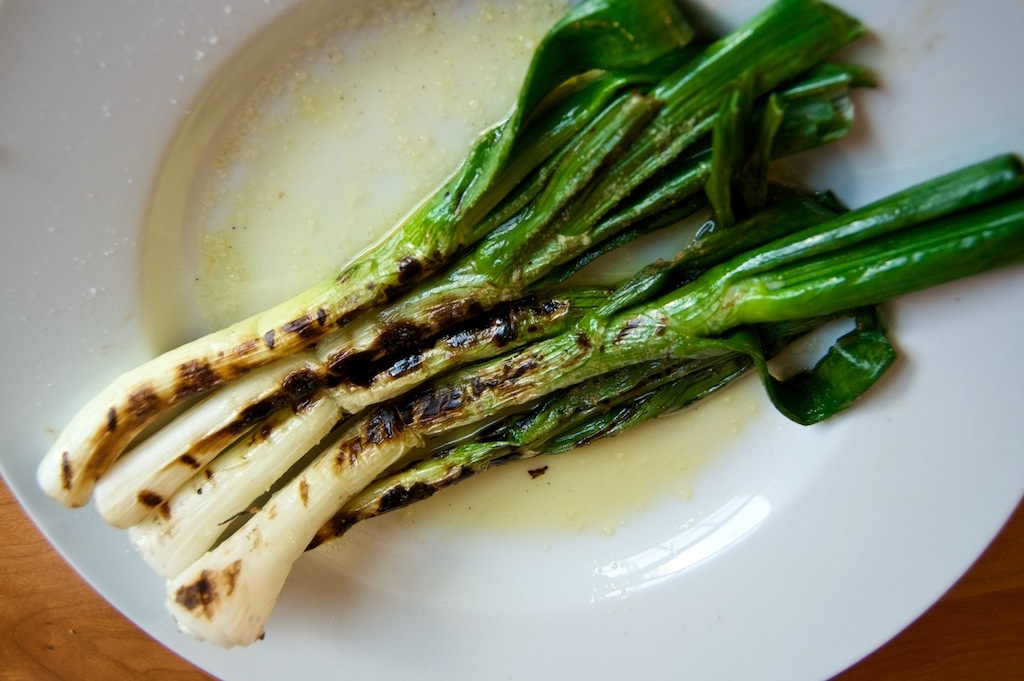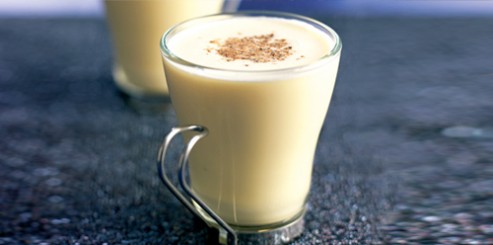Cooking
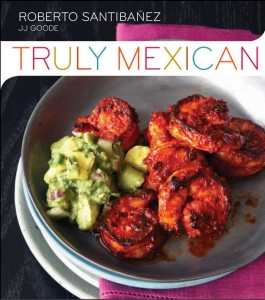 I’m not sure I’d ever made real Mexican food.  Don’t get me wrong.  Box tacos are a guilty pleasure.  But calling box tacos Mexican cooking would be like calling a jar of Ragu and boxed spaghetti Italian cooking.  The closest I’ve probably come is fish tacos with a side of fresh guacamole.  Maybe some of my enchiladas have gotten on the path.  But, with the purchase of a new cook book, it was time to give it a real try.
I’m not sure I’d ever made real Mexican food.  Don’t get me wrong.  Box tacos are a guilty pleasure.  But calling box tacos Mexican cooking would be like calling a jar of Ragu and boxed spaghetti Italian cooking.  The closest I’ve probably come is fish tacos with a side of fresh guacamole.  Maybe some of my enchiladas have gotten on the path.  But, with the purchase of a new cook book, it was time to give it a real try.
The new cook book (Truly Mexican) offers up recipes ranging from the simple to the devilishly complex.  I decided to ease in with a basic Adobo sauce (recipe below).  And the basic sauce was even easier than I expected.  Maybe a few extra minutes (at max, 15 minutes of real cooking time) compared to the crappy slightly seasoned tomato sauces I’ve played with in the past.
On my first go, I decided for pork (recipe below).  After making the sauce and cutting the pork, a bit of hands-off cooking yielded delicious fall apart pork.  With a little cilantro, Mexican cheese, and a small bit of sour cream I had some rock’n tacos.  For a full meal, I added some beans and rice.  So freak’n good!
This last weekend I made the same meal with chicken and a few eggs on the side for an at home brunch. Â The chicken recipe tracks the pork with a reduced cook time (for sliced chicken it was about 20 minutes of stove top in sauce cook time).
The cook book tells me the sauce can keep in the fridge for a week and on both cookings it seemed better the next day. Â (I’m eating Sunday brunch leftovers for lunch as I type.) Â I think I might next need to make the sauce a couple days in advance. Â Then I’ll be just 30 minutes away from my next taco night!

Basic Ancho Adobo
Ingredients:
- 2 1/2 onces ancho chiles (5 individual chiles), wiped clean, stemmed, slit open, seeded and deveined
- 1/2 cup water for blending, more if necessary
- 1/4 cup Seville orange juice or distilled white vinegar
- 2 garlic cloves, peeled
- 1/4 teaspoon fine sale or 1 teaspoon if kosher salt
- 1/4 teaspoon sugar
- 1/4 teaspoon dried oregano, preferably
Directions:
Heat a heavy skillet over medium-low heat, and toast the chiles 2 at a time, turning them over frequently until they’re fragrant and they’ve developed light brown blisters, about 1 1/2 minutes per batch. Soak the chiles in enough cold water to cover until they’re soft, about 30 minutes. Drain and discard the soaking water.
Put the 1/2 cup of fresh water in the blender jar with the chiles and the remaining ingredients. Â Blend until smooth, at least 3 minutes, adding a little more water in necessary to puree. Â For a silkier, smooth texture, strain the adobo through a medium-mesh sieve.
Pork in Adobo (Cerdo en Adobo)
Ingredients:
- 2 pounds pork shoulder or other pork stewing meat, cut into 1 1/2-inch cubes.
- 1/4 teaspoon fine salt, or 1 teaspoon kosher salt
- 2 tablespoons
- 1 1/2 cup of Adobo
- 2 cups of water or chicken stock
Directions:
Pat the pork dry and season it with the salt. Â Heat the oil in a 4 to 5 quart heavy pot or skillet over medium-high. Â Brown the pork (us e multiple batches is needed–avoid having the pork pieces sitting on top of each other), turning occasionally, 8 to 10 minutes per batch.
Reduce the heat and return all the pork to the pot. Â Carefully pour the adobo over the pork. Â If the adobo is in the blender, swish a little liquid around in the jar and add it to the pot. Â Simmer, stirring to coat the pork and fry the sauce, until the sauce is slightly thicker, about 5 minutes. Â Add the 2 cups of water.
Cook the pork, covered, in an oven in an ovenproof pot in a 350 degree oven for 1 1/2 to 2 hours. Â Season to taste, vinegar, and additional salt. Â (The recipe also instructs that you can reduce the heat to low, cover the pot, gently simmer the pork, adding a couple table spoons of water from time to time to maintain a silky texture until the pork is tender, 1 1/2 2 hours)
No.  I’m not dead.  Just warped-up in work and studies.  I’m in progress on a post on some great Mexican cooking I’ve been able to squeeze in.  Those meals have all included this been recipe from Truly Mexican a cook book I wrote-up a while back.
This black bean recipe is great pair for a taco night or just eating over rice. Â The mashing and added liquid means the beans are sitting in a tasty bean sauce. Â In fact, I’ve had this little dish over rice for dinner countless times in the last few months. Â (Aside: I love my rice cooker.) Â Reheated, the beans and rice make a great lunch. Â The recipe is easy to double or triple and it’s great to have some in the fridge for a near instant meal or side.
Ingredients:
- 1 (15-oz.) can black beans, including liquid
- 1/4 cup water
- 1 tablespoon olive oil
- 1/4 teaspoon garlic powder
- 1/4 teaspoon onion powder
- 1/4 teaspoon Chipotel Chile Powder (or sub in a couple drops of very hot hot sauce)
- 1/4 teaspoon dried oregano, preferably Mexican
Directions:
Put all the ingredients in a small saucepan and bring the mixture to a simmer over medium heat. Â Simmer the beans vigorously, mashing them slightly with potato masher or fork. Â Season to taste with slat.
BOOM! Â In under 10 minutes you’ve got yourself some awesome beans!
If you take cooking seriously, you know that there are lots of tertiary skills which go along with cooking which really have nothing to do with applying heat and seasoning to food. This will be – hopefully – the start of a recurring series which examines some of those aspects of the culinary world. What can you expect from this series of posts? Things along the lines of choosing a knife, sharpening a knife, roasting and grinding spices, seasoning a cast iron pan, choosing the right pan, things along those lines.
In the inaugural post in this series, we are going to examine…. cutting boards!
Wait…don’t go! I see you closing your laptop! Look, I know cutting boards are not a sexy topic, certainly not as fun as looking at knives. But really, what the hell is the point of buying a $400 kitchen knife if you’re going to destroy it within a week by using a glass cutting board? As with anything, the fundamentals may not be exciting, but without them you’re really going to struggle down the line. So read on!
Choosing Your Board
There are TONS of choices when it comes to cutting boards. You can go with wood, bamboo, plastic, glass, stone, steel, or rubber. Well, technically you can go with any of those choices. In reality, you can pick between wood, bamboo or plastic/rubber. “But Loren”, you cry, “my marble cutting board looks so snazzy! And it’s really easy to clean, I can even throw it in the dishwasher!” POPPYCOCK, I retort! Fine, I guess you can keep using it if you want, but promise me you won’t ever spend more than $10 on a knife, because you will be throwing money away. A glass or marble or steel or stone cutting board is pretty much the worst possible thing you can do to your kitchen knives. Any time your cutting board is made of a material which is very hard, it will very rapidly dull your knife, and might even chip the blade if you’re not careful. These materials are just not meant to be used as cutting boards, despite how easily they clean.  If you already have one, you don’t have to get rid of it, just use it as a cheeseboard or serving platter or something.
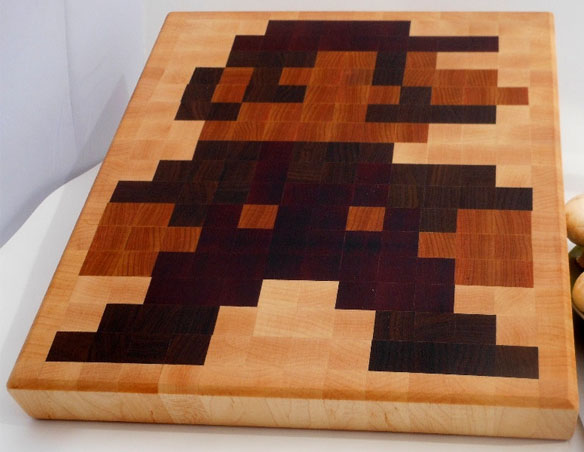
The best part about butcher blocks? They are ideal for recreating the 8 bit video game characters of your childhood.
Having settled that, let’s look at wood or bamboo cutting boards. First, the upsides: they look nice, and they are very easy on your knives. The downsides? Well, you can’t put them in the dishwasher, the bigger butcher blocks can be quite heavy, and they require a little maintenance on your part.
There is also a difference between thinner, flat grain boards and the big, thick butcher blocks which are end grain boards. While the ends grain boards are a little less convenient since they are more heavy and ungainly, they are much, much better for your knives. Basically, because the grains are running vertically, your knife essentially pushes the grain apart rather than crushing it or cutting it. When you take the knife away, the grains actually close back up so these boards are more resistant to showing cuts and nicks as well.
As for plastic boards: they are cheap, they clean up easily, they can go in the dishwasher, and they’re light. Some of them even have rubber feet or bottoms built in to prevent slipping on the counter. The problem? They just don’t lend the same kind of gravitas to your kitchen or your cooking. If you’re a serious cook, it makes sense to have a serious board, doesn’t it?
Really the best thing to do is have several. I have one wooden butcher block, one large bamboo board, and a few smaller plastic boards. This provides me with a little flexibility. If I’m pressed for time, I can use a board that can be put in the dish washer. If I’m prepping multiple components of a good meal, I can do all the veggies on a wood board and switch to plastic for the meat to prevent cross contamination.
 Caring for your Cutting Board
Assuming you haven’t already tossed aside my concerns about the relative lack of gravitas and decided to go exclusively with plastic boards, you are going to need to know how to clean maintain your wood or bamboo cutting board.The first rule of cleaning wood boards is: do not submerge them in water. The second rule of cleaning wood cutting boards is: DO NOT SUBMERGE THEM IN WATER. Being a piece of dried wood, your board’s natural reaction to being submerged in water for any length of time will be to absorb that water, which is going to cause you all kinds of problems, namely the wood will bulge, warp and crack. Once these things start happening, there is really no reversing them, you can only hope to keep the problem from getting worse. So, to clean your cutting board, just use a damp cloth and mild soap. This isn’t enough to seriously disinfect, but that’s OK because you already have a plastic board for cutting your meat, right? No? Jeez… alright. If you absolutely must use your wooden board for all tasks, including cutting meat, you can use a mild bleach or vinegar solution to disinfect the wood. Don’t make this a habit though.
Finally, you’ll need to oil your board every month or two to keep it up to shape. There are a good amount of products out there which are specifically designed for cutting board maintenance, some including protective waxes, but you really don’t need to go that route. Just a simple bottle of mineral oil will do the trick. Don’t try to use a vegetable oil of any kind, as they will turn rancid. Â Apply a
generous layer to one side of your board and wipe down with a paper towel or clean rag to make sure you have even coverage, then let the board sit for a few hours. Come back and get the other side, along with the vertical and horizontal faces and let sit for another few hours. If you have a big, thick board or block, you may need to repeat this process several times. Afterward, if there is still an oily film on the board, give it a quick wash.
Mise en place: the French phrase literally meaning “everything in place.”  If you’ve watched Top Chef, Chopped, Iron Chef, or any in the litany of cooking shows out there you’ve heard those words.  Its kitchen and chef talk for what you have when you’ve prepared and arranged all your ingredients for whatever it is you’re going to cook.
A bit back, at a work happy hour, I was talking with some co-workers about cooking and one mentioned that his wife has started “setting everything out before cooking like on the shows.” Â When I mentioned I do the same, I got some weird looks and a couple “whys.” Â I had to think for a second on the why.
I haven’t always done this, but over time just slowly started.  A few months back, I was able to pick-up, on the cheap, some nested bowls, ranging from a couple of teaspoons to huge, and really got into the preparation.  Over time, I just realized that the setup actually makes the cooking process quicker and easier.  But, most importantly, mise en place forces me to read the recipe through, think about what I’m going to do, and check a recipe for any gaps.
The last point can be critical for new recipes.  A few weeks, I tried a recipe from Pinetrest. A relatively simple pasta sauce recipe that looked simple to take on.  The problem? The recipe didn’t list retained pasta water in the ingredient list or mention until after I would have discarded it.  I was saved by the mise en place; by looking over the recipe and preparing I was ready for the curve ball thrown at me.
I may not need to worry about my mise en place when I’m making a dish I know and love well, but, when exploring the new or making the complex having everything, in its place is a winning strategy.
As almost any of my  local friends could tell you, I am hopelessly hooked on this recipe. I originally found it in a Splendid Table Summer Grilling handbook I got for joining Minnesota Public Radio (charitable brag), and I think I may have made it every single time I’ve grilled in the last 5 months. I’m not sure I’ve ever found another recipe which has such an insanely out of balance ratio of time, effort and money input for each unit of tastiness returned. This whole thing takes about 5 minutes to prep, it cooks on the same grill and at the same time as whatever else you might be grilling, and the end result is just fantastic. The only complaint I have with this recipe is that it may upstage whatever meat you’re grilling with it!
First prep the scallions by rinsing and drying all of them, then cutting off the roots at the bottom as well as the top 2 inches from the green end.  The asparagus  needs to be rinsed and trimmed as well. There’s a nifty trick for this, which ensures that you will always remove all the tough, fibrous part of the stem. Grasp the cut end of the asparagus in one hand, and then hold 2-3 inches up the stalk with your other. Bend the stalk until it snaps, and throw away the short end. There’s no consistent point that asparagus stems turn from tough to tender, and this method will allow each stalk to break naturally at that point.
Place all of the onions and asparagus on a platter or jellyroll pan, then drizzle on 2 tbsp or so of olive oil. The exact amount of each is not that important, but I usually do 2 bunches of scallions and 1 of asparagus. Also, if you’re able to find the smaller asparagus stalks, go for those. Asparagus, being much denser then scallions, takes significantly longer to cook. The small, thin ones seem to cook at roughly the same time, so those are ideal. Toss the veggies with the oil, and whatever seasoning you want. You could use just salt and pepper, or change it up for your tastes. I usually use Cavender’s Greek seasoning for this, it seems to work pretty well.
Don’t go nuts with seasoning the veggies, because after they grill you’re going to top with a balsamic vinaigrette. It doesn’t need to be perfectly executed, just mix balsamic, olive oil, Dijon mustard, garlic, and an herb or two. If you need a recipe to work off of, we’ve previously covered the America’s Test Kitchen vinaigrette recipe here, just make sure you don’t use the full amount. 1/2 cup or so of vinaigrette will be plenty.
Grill the veggies for 5 minutes or so, depending on how hot you have the coals. If they start to burn just move to a cooler part of the grill. When everything has a bit of color and has gone slightly limp, it should be ready. Toss the veggies with the balsamic mixture and serve immediately. You can top with some shaved Parmesan if you like, but its damn good as it is.
Eggnog is one of my favorite things about the holiday season, next to unwrapping presents, sitting by a fireplace and busting through snowdrifts in my Jeep. If you like the storebought stuff, you will really love it when made from scratch. I will put one caveat to that however: if you don’t or can’t drink alcohol, just buy the carton from the store. Not that the home made nog won’t be good without the booze, but the difference in taste really won’t be enough to justify getting into this somewhat involved preparation. This recipe is an amalgam of Alton Brown’s and the one from Joy of Cooking, and makes about 6-7 cups. Scale up if you are serving a large party.
- 4 egg yolks
- 1/3 cup sugar, plus 1 tablespoon
- 1 pint whole milk
- 1 cup heavy cream
- 3 oz bourbon ( can also use brandy or dark rum, or all 3)
- 1 teaspoon freshly grated nutmeg (and a little more to garnish each cup)
- 4 egg whites
In the bowl of a stand mixer, beat the egg yolks until they lighten in color. Gradually add the 1/3 cup sugar and continue to beat until it is completely dissolved. Add the bourbon and cover, then let sit in the fridge for 1 hour. This step should mellow some of the raw eggy flavor. Add the milk, cream, bourbon and nutmeg and stir to combine. In a different bowl, beat the egg whites until soft peaks form. Hopefully you have a hand or stand mixer, or you’re going to work up quite a sweat with all of this egg beating. Add the remaining tablespoon of sugar and continue beating until stiff peaks form. Fold the egg whites into the other liquid, and serve. It’s important to make sure your ingredients are as chilled as possible when putting everything together, because if you have to put the final product back into the fridge to chill further, the liquid and the egg white foam will separate. You may want to try putting the ingredients and mixing bowls in the freezer for 10 or 15 minutes before starting the recipe.
In regards to the booze: There is a decent amount of variation in the amount of alcohol called for. Alton Brown’s recipe calls for 3 tablespoons, to make 6-7 cups. The Joy of Cooking recipe calls for 4-6 cups for a recipe about 3x as large. In this area, I follow the wise words of Mark Twain, when he wrote “too much of anything is bad, but too much Whiskey is just enough.” I would suggest making the recipe as outlined above, then giving it a try and adding more to taste. Myself, I would almost certainly double the amount of bourbon, but give it a try and see what you think.
 Last year, Loren posted about gifting Good Meat to his brother.  After receiving the book, Loren’s brother sat down to give it Saturday read with a few cups of tea.  I had the much the same experience when I got my hands on Truly Mexican.
Last year, Loren posted about gifting Good Meat to his brother.  After receiving the book, Loren’s brother sat down to give it Saturday read with a few cups of tea.  I had the much the same experience when I got my hands on Truly Mexican.
The author Roberto Santibanez is the head chef of Fonda (the restaurant that redefined Mexican food for me).  Before I’d eaten at Fonda, I heard Santibanez on The Splendid Table and knew I had to learn more about real Mexican food.  My meals at Fonda have blown me away and I could only resist buying this book for so long.
The cookbook offers up page after page of instruction, recipes, and beautiful photos.  The reader is taken through the basics (how do you core a tomato, roast garlic, or pit an avocado) through easily executed salsas, guacamoles, and adobos to the advanced 22 ingredient multi-hour process that is the legendary mole poblano.
Another thing I love about this cookbook is the fact that Santibanez recognizes that owning the book doesn’t mean that you automatically live in Mexico or give you access to markets filled with the proper ingredients. To help bridge the gap between grocery store reality and Mexican cooking necessity, Truly Mexican lists a number of websites where more obscure chilies and other ingredients can be purchased and offers a few alternative chili peppers for some of the dishes.  I know it would be great to make my way to a proper store to purchase these items, but it’s nice to know I don’t have to to get what I need.
I haven’t gotten to cooking anything from here yet, but, once I’ve take care of Thanksgiving leftovers, Taco Tuesday better look out!  For now, I’m happy to page through this tasty tome before bed.
I want you to know that I take this title seriously. This is not only the best stuffing I’ve ever had, it’s the best stuffing I can conceive of. I am willing to say right now that this is the perfect stuffing recipe, and if you say otherwise, I challenge you to a pistol duel at dawn on the tennis court attached to the Burj Al-Arab hotel in Dubai. What makes this stuffing so good is a perfect trifecta of white wine, cheese and wild rice. Doesn’t sound like that much of an epiphany, right? Trust me, it’s amazing. The melted cheese gives it a rich flavor, the white wine provides a bright acidic flavor to cut through everything, and the wild rice rounds out the taste as well as providing an interesting texture to a side dish that can sometimes be as texturally interesting as that jar of paste you used to grub on in kindergarten.
I probably should have posted this before Thanksgiving, but I really wanted to make it myself first. Prior to this year, I’ve only had this when my mother made it, and you just never know exactly how a recipe is going to work before you do it yourself. Plus, this way, you now have an excuse to make a turkey again for Christmas!
[DDET The ingredients list is rather long on this one]
- 3/4 cup wild rice – uncooked
- 2 cups water
- 2 chicken bullion cubes
- 3/4 tsp salt
- 3 tbsp butter
- 3/4 cup white wine
- 3 tbsp parsley
- 1 medium onion, chopped
- 1 cup chopped celery
- 1/2 cup mushrooms, sliced
- 3 cloves garlic, minced
- 1/2 tsp rosemary
- 1/2 tsp poultry seasoning (use more if bread cubes are not seasoned)
- 1/2 tsp sage
- 1/4 tsp savory ( I actually omitted this because I couldn’t find it in stores the night before turkey day)
- 1/8 tsp thyme
- 1 pound grated mild white cheese (monterey jack, muenster, mozz)
- 2 ounces grated parmesan cheese (about 1/2 cup)
- 10 oz stuffing (seasoned or not)
- Salt and pepper to taste
[/DDET]
Rinse the rice under cold water, then cook in the water, along with the bullion cubes, salt and 1tbsp of the butter. Cover and boil for 10 minutes before reducing the heat and simmering for 30 minutes. Remove from the heat and do not drain the liquid. I will admit that at this point I was slightly concerned with the aroma. I’d never cooked wild rice before, and just to warn you there is slightly… sulfurous odor that comes about. This is not cause for concern. That smell does not at all portend bad things for the flavor of the final dish.
Now sauté the onions, celery and mushrooms on medium heat with the remaining two tablespoons of butter. After two minutes, add the garlic and herbs. Cook for an additional two minutes, then remove from the heat.
In a large bowl (seriously, it needs to be pretty big you let you mix everything together), add the cheeses, dry stuffing, parsley and the sautéed veggies. Pour the wine into the sauté pan and scrape down the sides to get all the tasty bits, then pour that in the bowl as well, along with the rice and water. Mix well.
The recipe says this makes enough stuffing for a 20lb turkey. I myself subscribe to the Alton Brown school of turkey prep, which states that adding stuffing to your bird will destroy it. It takes so long for the stuffing to reach the appropriate temperature (165, same as the bird) that you will have to overcook the breasts in order to make the stuffing safe to eat. It just doesn’t make sense. Just go ahead and cook this stuffing in a casserole dish, or soufflé dish, or, hell, even a cake pan. I believe I baked it at 350 for about 10-15 minutes, then another 10 minutes or so later on to warm it up. The gooeyness of the melted cheese will make it pretty forgiving in terms of overcooking it.
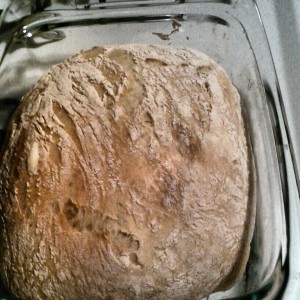 I made bread.  Let me type that I again.  I made bread!  And I am embarrassingly satisfied with myself for accomplishing  something that billions have managed to pull off ever since humans first gave-up hunting and gathering for this whole civilization experiment.
I made bread.  Let me type that I again.  I made bread!  And I am embarrassingly satisfied with myself for accomplishing  something that billions have managed to pull off ever since humans first gave-up hunting and gathering for this whole civilization experiment.
Baking bread, and baking in general, has always been a bit of a barrier to me.  Something outside my core competency.  I’ve seen people make bread, but the recipes just seemed doomed to failure in my hands.  But last week I was reminded of a supposedly simple can’t fail recipe.  I had the ingredients about and figured I’d give it a shot.
Ingredients:
- 3 cups all-purpose or bread flour, more for dusting
- 1 pack instant yeast
- 1¼ teaspoons salt
- 1 1/2 cups water (the original NY Times recipe called for 1 5/8 – I think that’s a really annoying measurement and 1 1/2 works just fine)
In a large bowl combine the flour, yeast, and salt. Â You can also add ingredients as desired (raisins, nuts, etc.). Â Add water, and stir until blended. Cover bowl with plastic wrap. Let dough rest at least 12 hours, Â but preferably about 18, at room temperature.The dough is ready when its surface is dotted with bubbles.
Lightly flour a work surface and place the dough on it. Sprinkle the dough with a little more flour and fold it over on itself twice. Cover loosely with plastic wrap and let rest about 15 minutes.
Using enough flour to keep the dough from sticking to work surface or to your fingers, gently and quickly shape into a ball. Put the dough down on a re-dusted work surface and dust with more flour, bran, cornmeal or whatever you’d like. Cover with a cotton towel and let rise for about 2 hours. When it is ready, dough will have more than doubled in size.
At least a half-hour before dough is ready, heat oven to 450 degrees. Put a 6- to 8-quart heavy covered pot (cast iron, enamel, Pyrex or ceramic) in oven as it heats. When dough is ready, carefully remove pot from oven. Slide the dough into pot. Â It might look like a mess, but that’s just fine. Cover with lid and bake 30 minutes, then remove lid and bake another 15 to 30 minutes, until loaf has browned.
The Results:
Bread! Â And a house that is filled with the smell of fresh baked bread. For almost zero active work!
After playing with the basic recipe I’m convinced you would have to intentionally try to make it fail.  At four in the morning, after a night of poker playing and more than my fair share of whiskey, I tried some “creativity.” I’m told I looked like Muppets’ Swedish Chef–arms and flour flying everywhere–and sounded much like the same.  In my enlightened state, I decided beer is better than water and substituted a cup of it in.  A few tablespoons of brown sugar seemed like a good idea, as did a small palm full of black finishing salt.  The next night I was almost afraid to bake the monstrosity.  But, though a little on the salty side and runny before baking, the bread turned out perfectly enjoyable!  (They say a four year old can make it and now I believe it!)
I’m very excited to experiment with additions and twists to this recipe and to have fresh bread around as the weather cools in these dark winter months.
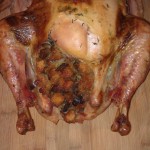 Everyone wants it.  Dreams of it.  Is disappointed when they don’t get it – when they take a bite out of the thanksgiving turkey and find it to be…. DRY!
Everyone wants it.  Dreams of it.  Is disappointed when they don’t get it – when they take a bite out of the thanksgiving turkey and find it to be…. DRY!
This problem that faces our great nation every November can be avoided. Brine to keep your turkey moist.  I really don’t know why the airwaves aren’t full of PSAs informing the public of this process.
A simple brine is just salt water.  When you soak your meat in this salt water you get more tender and more moist meat.  And, as an added bonus, the brine can be used as a vector for flavor conveyance.  BUT YOU NEED TO START EARLY – one to three days before the big day.  So hurry!
Here is how you do it:
For every five pounds of turkey get half a gallon water and a half cup of kosher salt.
In a large pot bring the water to a simmer and dissolve the salt. Â Now you have a pot of brine. Â Let the brine return to room temperature (we don’t want to soak the bird in warm water). Â If your turkey fits in your pot, drop it in and put it in the fridge. Â If your turkey is too big, get a heavy duty trash bag, place in the turkey and pour in the brine. Â If using the trash bag, Â I recommend operating in the sink and double or triple layering on bags to be on the safe side. Â The bird should be fully submerged.
Whether in the pot or in the bag, put the turkey and brine in the fridge for one – three days.  Prior to baking, rinse the bird to remove any excess salt and cook how ever family tradition dictates.
A quick Google search will yield countless things you can add to the brine to impart additional flavor (citrus, apple cider, herbs, etc.).  The flavor imparted is usually relatively minor, but can give a bit of an extra dimension.  If the flavors makes you nervous, skip it.  But, unless you are deep frying, don’t skip the brine! The turkey will be moist at the dinner table and for the leftovers in the days to come.
